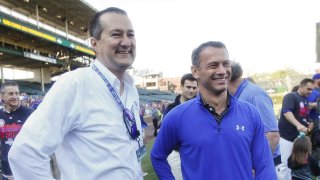
A rebuild by any other name smells just as bittersweet originally appeared on NBC Sports Chicago
As much as the Cubs’ media conference early this week was a great chance to get a glimpse of new general manager Carter Hawkins, it offered an even better chance to try to unscramble the mind-numbing mixture of messages ownership and the front office have been sending about their offseason plans in recent weeks.
The operative word in that sentence being “try.”
Team president Jed Hoyer, a man who in July said he didn’t know what the word “rebuild” means, was asked Monday what his definition of spending “intelligently” means — after dropping that qualifier a couple weeks ago regarding his free agency plans.
And to fans who may want to see big improvements quickly, the definitions didn’t sound any better the second time around.
“Free agency’s valuable. Free agency’s also dangerous,” Hoyer said.
Which brings all the word salads tossed by Hoyer and chairman Tom Ricketts (in a couple of recent letters to fans) right back where they were when the Cubs’ worst season in eight years ended — if not back to the July 30 trade deadline when Hoyer blew up what was left of the championship core.
Goodbye, Carlos Correa. And might as well take Robbie Ray and Marcus Stroman with you — and any other big-ticket free agent who might inject hope and excitement into a fan base wondering how many years it’ll be before the actual Cubs rejoin all those ex-Cubs in the postseason.
Whether Hoyer can deliver on his promise to try to “field a team that’s competitive next year,” it figures to be done again with a roster built with a lot of short-term contracts, a process that makes it a roster again built to blow up at the deadline. By definition.
“When you’re talking about spending in free agency, there’s a danger in free agency of committing a lot of years and a lot of dollars to players sort of in the decline phase of their career,” Hoyer said.
Feeling out of the loop? We'll catch you up on the Chicago news you need to know. Sign up for the weekly Chicago Catch-Up newsletter here.
“I think that you always have to be mindful of what the biggest value is of that contract.”
Cool.
Makes sense, right?
But how does that square with Hoyer’s assertion earlier this month that he would “certainly be active”? Or with that letter last week by Ricketts that seemed to double down on the big promises:
“Jed and the team are now focused on reloading our roster. We have the resources necessary to compete in 2022 and beyond, and we will use them,” that letter said in part.
Reloading. Resources. Compete. Active. Danger. Value.
Define them any way you want.
And don’t forget “Rebuild.”
Because here’s what seems most certain about where the Cubs and their immediate plans for building a roster have them: Most of their in-house possibilities for young, potential impact core players are in the low minors and at least a couple years away (with a few exceptions such as big-leaguer Nico Hoerner and Triple-A outfielder Brennen Davis).
And if they don’t supplement that core with a long-term impact player or two with their newly available payroll flexibility, then this competitive process is at least a year-to-year proposition until then, if not a multi-year rebuilding process.
“There’s a reason that the best organizations are generally built from within, and they’ll use free agency to sort of finish off the club,” Hoyer said. “Building a club through free agency is really challenging. So when we talk about intelligent spending, that’s ultimately how I see it: You want to bring talent to the organization; there’s only so many pipelines you can do it; you have to be really careful.”
That’s where the “decline-phase” part of the “danger” comes into play, he said — at which point he offered a reminder that the Cubs didn’t go big the last time until they had a core in place in 2015 and ’16.
That’s when they got aggressive in free agency, he said, “because we had so many zero-to-three [-year service time] players that we really [were able] to pack that much talent on our roster. As we were building, we really didn’t do that.”
That timelline looks years away at best, given where the organization is now in terms of the best guesses on pre-arbitration impact players. Just by doing the math on those players’ timelines.
That would seem to preclude aggressiveness in the next couple of years, at least. By definition.
“I don’t think so,” Hoyer said, pushing back. “What I’m trying to explain is — you guys keep on asking what does that mean, ‘spending intelligently,’ and that’s what I’m trying to get at.”
So not spending a lot on any one free agent, right?
“Yeah, I think there’s different ways to do it,” he said. “You’ve seen teams that have been incredibly successful and have had really good offseasons by being really targeted in what they go after. I think there’s plenty of examples of that. I don’t think you have to necessarily allocate your dollars in one spot.”
Whether that means they go cheap or short-term on the much-needed shortstop, so much for Correa. Never mind a top-of-the-market pitcher.
“I wouldn’t say that necessarily,” Hoyer said of avoiding big, long-term deals this winter, “but I would say we’re going to be aware of where we are in our eventual timeline.”
Eventual timeline. Intelligent spending.
To-mayto, To-mahto.
This Cubs rebuild might not look like the last one.
But it doesn't take Webster to define it.




